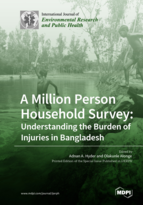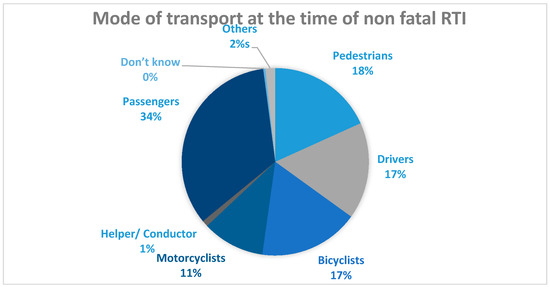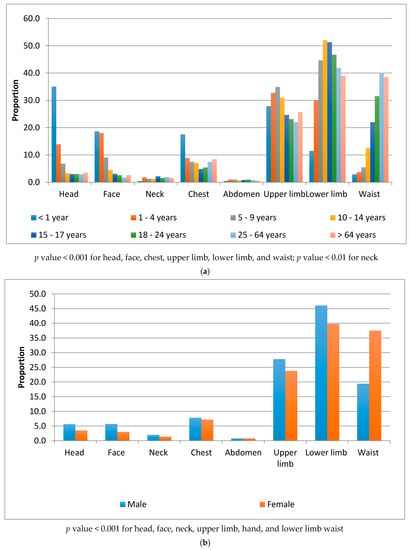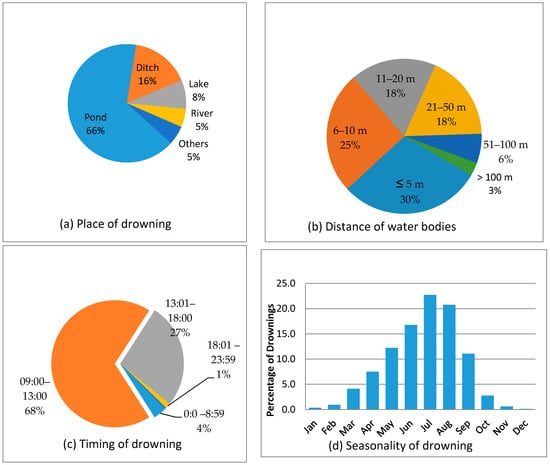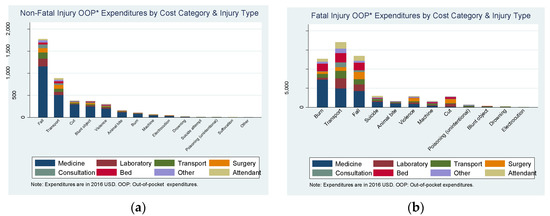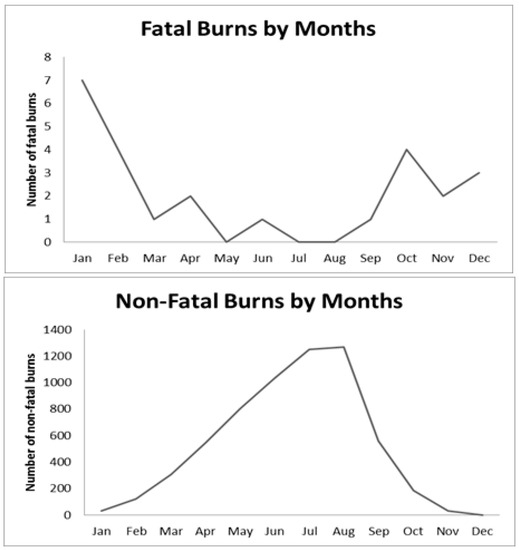A Million Person Household Survey: Understanding the Burden of Injuries in Bangladesh
(Closed)
Printed Edition Available!
A printed edition of this Special Issue is available
here.
Project Leader
 Prof. Dr. Adnan A. Hyder
Prof. Dr. Adnan A. Hyder
 Prof. Dr. Adnan A. Hyder
Prof. Dr. Adnan A. Hyder
E-Mail
Website
Project Leader
Health Systems Program, Department of International Health, Johns Hopkins International Injury Research Unit, Johns Hopkins University, Wolfe Street, Baltimore, MD 21205, USA
 Dr. Olakunle Alonge
Dr. Olakunle Alonge
 Dr. Olakunle Alonge
Dr. Olakunle Alonge
E-Mail
Website
Project Leader
Health Systems Program, Department of International Health, Johns Hopkins International Injury Research Unit, Johns Hopkins University, Wolfe Street, Baltimore, MD 21205, USA
Share This Project Collection
Project Overview
Dear Colleagues,
The Johns Hopkins International Injury Research Unit (JH-IIRU) at the Johns Hopkins Bloomberg School of Public Health is initiating a Project Collection on the epidemiology of fatal and non-fatal injuries in Bangladesh, based on a survey of 1.2 million people.
With support from the Bloomberg Philanthropies, JH-IIRU, in collaboration with two partners in Bangladesh—the Center for Injury Prevention and Research and the International Center for Diarrheal Disease Research—is conducting a large-scale, child-injuries prevention project called “Saving of Lives from Drowning” (SoLiD) in Bangladesh. The study involves active injury and demographic surveillance for about 1.2 million people, and the implementation of two childhood drowning prevention interventions (playpens and crèches). The SoLiD project also includes a baseline survey that was conducted in 2013 in seven rural sub-districts of Bangladesh to collect demographic and epidemiological data on all injury and non-injury outcomes (both fatal and non-fatal) for the 1.2 million people under surveillance.
The baseline survey is one of the largest injury surveys in the world and provides unique knowledge on the burden, epidemiology, and consequences of different mechanisms of injury in Bangladesh across all demographic profiles. The project collection will present various descriptive epidemiologies and burden analyses on different types of injuries using the rich survey data. Unlike similar studies that have looked at injuries through health facility-based data, the use of extensive population-based data is likely to yield accurate estimates and capture other injury outcomes that do not necessarily present at the health facility level. This body of work will contribute to efforts to accurately estimate the global burden of diseases and will contribute to injury prevention across all demographic profiles in low- and middle-income countries.
The project collaborators are exclusively contributing the Project Collection.
Prof. Dr. Adnan A. Hyder
Dr. Olakunle Alonge
Project Leaders
Manuscript Submission Information
Manuscripts should be submitted online at www.mdpi.com by registering and logging in to this website. Once you are registered, click here to go to the submission form. Manuscripts can be submitted until the deadline. All submissions that pass pre-check are peer-reviewed. Accepted papers will be published continuously in the journal (as soon as accepted) and will be listed together on the collection website. Research articles, review articles as well as short communications are invited. For planned papers, a title and short abstract (about 100 words) can be sent to the Editorial Office for announcement on this website.
Submitted manuscripts should not have been published previously, nor be under consideration for publication elsewhere (except conference proceedings papers). All manuscripts are thoroughly refereed through a single-blind peer-review process. A guide for authors and other relevant information for submission of manuscripts is available on the Instructions for Authors page. International Journal of Environmental Research and Public Health is an international peer-reviewed open access monthly journal published by MDPI.
Please visit the Instructions for Authors page before submitting a manuscript.
The Article Processing Charge (APC) for publication in this open access journal is 2500 CHF (Swiss Francs).
Submitted papers should be well formatted and use good English. Authors may use MDPI's
English editing service prior to publication or during author revisions.
Keywords
- injury
- epidemiology
- Bangladesh
- suicide
- burns
- falls
- road traffic injuries
- drowning
- cost effectiveness
- cognitive assessment
- care-seeking
- trauma
Published Papers (10 papers)
Open AccessEditorial
Burden of Injuries in Bangladesh: A Population-Based Assessment
by
Priyanka Agrawal and Adnan A. Hyder
Cited by 2 | Viewed by 3467
Abstract
Injuries claim over 5 million lives, with more than 90% of those occurring in low- and middle-income countries (LMICS) [...]
Full article
Open AccessArticle
Pattern of Road Traffic Injuries in Rural Bangladesh: Burden Estimates and Risk Factors
by
Md. Kamran Ul Baset, Aminur Rahman, Olakunle Alonge, Priyanka Agrawal, Shirin Wadhwaniya and Fazlur Rahman
Cited by 23 | Viewed by 6399
Abstract
Globally, road traffic injury (RTI) causes 1.3 million deaths annually. Almost 90% of all RTI deaths occur in low- and middle-income countries. RTI is one of the leading causes of death in Bangladesh; the World Health Organization estimated that it kills over 21,000
[...] Read more.
Globally, road traffic injury (RTI) causes 1.3 million deaths annually. Almost 90% of all RTI deaths occur in low- and middle-income countries. RTI is one of the leading causes of death in Bangladesh; the World Health Organization estimated that it kills over 21,000 people in the country annually. This study describes the current magnitude and risk factors of RTI for different age groups in rural Bangladesh. A household census was carried out in 51 unions of seven sub-districts situated in the north and central part of Bangladesh between June and November 2013, covering 1.2 million individuals. Trained data collectors collected information on fatal and nonfatal RTI events through face-to-face interviews using a set of structured pre-tested questionnaires. The recall periods for fatal and non-fatal RTI were one year and six months, respectively. The mortality and morbidity rates due to RTI were 6.8/100,000 population/year and 889/100,000 populations/six months, respectively. RTI mortality and morbidity rates were significantly higher among males compared to females. Deaths and morbidities due to RTI were highest among those in the 25–64 years age group. A higher proportion of morbidity occurred among vehicle passengers (34%) and pedestrians (18%), and more than one-third of the RTI mortality occurred among pedestrians. Twenty percent of all nonfatal RTIs were classified as severe injuries. RTI is a major public health issue in rural Bangladesh. Immediate attention is needed to reduce preventable deaths and morbidities in rural Bangladesh.
Full article
►▼
Show Figures
Open AccessArticle
Developmental Assessments during Injury Research: Is Enrollment of Very Young Children in Crèches Associated with Better Scores?
by
Divya Nair, Olakunle Alonge, Jena Derakhshani Hamadani, Shumona Sharmin Salam, Irteja Islam and Adnan A. Hyder
Cited by 7 | Viewed by 7547
Abstract
The Developmental Study is part of a larger intervention on “saving of lives from drowning (SoLiD)” where children were enrolled either into crèches (daycare centers) or playpens to prevent drowning in rural Bangladesh. Sampling ~1000 children between the ages of 9–17 months, we
[...] Read more.
The Developmental Study is part of a larger intervention on “saving of lives from drowning (SoLiD)” where children were enrolled either into crèches (daycare centers) or playpens to prevent drowning in rural Bangladesh. Sampling ~1000 children between the ages of 9–17 months, we compared problem-solving, communication, motor and personal-social outcomes assessed by the Ages and Stages Questionnaire in the two interventions. After controlling for variables such as home stimulation in multivariate regressions, children in crèches performed about a quarter of a standard deviation better in total scores (
p < 0.10) and 0.45 standard deviations higher in fine motor skills (
p < 0.05). Moreover, once the sample was stratified by length of exposure to the intervention, then children in crèches performed significantly better in a number of domains: those enrolled the longest (about 5 months) have higher fine motor (1.47,
p < 0.01), gross motor (0.40,
p < 0.05) and personal-social skills (0.95,
p < 0.01) than children in playpens. In addition, children in crèches with the longer exposure (about 5 months) have significantly higher personal-social and problem-solving scores than those in crèches with minimum exposure. Enrollment in crèches of very young children may be positively associated with psychosocial scores after accounting for important confounding variables.
Full article
Open AccessArticle
The Burden of Suicide in Rural Bangladesh: Magnitude and Risk Factors
by
Shumona Sharmin Salam, Olakunle Alonge, Md Irteja Islam, Dewan Md Emdadul Hoque, Shirin Wadhwaniya, Md Kamran Ul Baset, Saidur Rahman Mashreky and Shams El Arifeen
Cited by 33 | Viewed by 6012
Abstract
The aim of the paper is to quantify the burden and risk factors of fatal and non-fatal suicidal behaviors in rural Bangladesh. A census was carried out in seven sub-districts encompassing 1.16 million people. Face-to-face interviews were conducted at the household level. Descriptive
[...] Read more.
The aim of the paper is to quantify the burden and risk factors of fatal and non-fatal suicidal behaviors in rural Bangladesh. A census was carried out in seven sub-districts encompassing 1.16 million people. Face-to-face interviews were conducted at the household level. Descriptive analyses were done to quantify the burden and Poisson regression was run to determine on risk factors. The estimated rates of fatal and non-fatal suicide were 3.29 and 9.86 per 100,000 person years (PY) observed, respectively. The risk of suicide was significantly higher by 6.31 times among 15–17 and 4.04 times among 18–24 olds compared to 25–64 years old. Married adolescents were 22 times more likely to commit suicide compared to never-married people. Compared to Chandpur/Comilla district, the risk of suicide was significantly higher in Narshingdi. Students had significantly lower risk of non-fatal suicidal behavior compared to skilled laborers. The risk of non-fatal suicidal behavior was lower in Sherpur compared to Chandpur/Comilla. Among adolescents, unskilled laborers were 16 times more likely to attempt suicide than students. The common methods for fatal and non-fatal suicidal behaviors were hanging and poisoning. Suicide is a major public health problem in Bangladesh that needs to be addressed with targeted interventions.
Full article
Open AccessArticle
Epidemiology of Fall Injury in Rural Bangladesh
by
Shirin Wadhwaniya, Olakunle Alonge, Md. Kamran Ul Baset, Salim Chowdhury, Al-Amin Bhuiyan and Adnan A. Hyder
Cited by 18 | Viewed by 5340
Abstract
Globally, falls are the second leading cause of unintentional injury deaths, with 80% occurring in low-and middle-income countries. The overall objective of this study is to describe the burden and risk factors of falls in rural Bangladesh. In 2013, a large household survey
[...] Read more.
Globally, falls are the second leading cause of unintentional injury deaths, with 80% occurring in low-and middle-income countries. The overall objective of this study is to describe the burden and risk factors of falls in rural Bangladesh. In 2013, a large household survey covering a population of 1,169,593 was conducted in seven rural sub-districts of Bangladesh to assess the burden of all injuries, including falls. The recall periods for non-fatal and fatal injuries were six and 12 months, respectively. Descriptive, bivariate and multiple logistic regression analyses were conducted. The rates of non-fatal and fatal falls were 36.3 per 1000 and 5 per 100,000 population, respectively. The rates of both fatal and non-fatal falls were highest among the elderly. The risk of non-fatal falls was higher at extremes of age. Lower limb and waist injuries were frequent following a fall. Head injuries were frequent among infants (35%), while lower limb and waist injuries were frequent among the elderly (>65 years old). Injuries to all body parts (except the waist) were most frequent among men. More than half of all non-fatal falls occurred in a home environment. The injury patterns and risk factors of non-fatal falls differ by sociodemographic factors.
Full article
►▼
Show Figures
Open AccessArticle
Impact of First Aid on Treatment Outcomes for Non-Fatal Injuries in Rural Bangladesh: Findings from an Injury and Demographic Census
by
Dewan Md Emdadul Hoque, Md Irteja Islam, Shumona Sharmin Salam, Qazi Sadeq-ur Rahman, Priyanka Agrawal, Aminur Rahman, Fazlur Rahman, Shams El-Arifeen, Adnan A. Hyder and Olakunle Alonge
Cited by 13 | Viewed by 6263
Abstract
Non-fatal injuries have a significant impact on disability, productivity, and economic cost, and first-aid can play an important role in improving non-fatal injury outcomes. Data collected from a census conducted as part of a drowning prevention project in Bangladesh was used to quantify
[...] Read more.
Non-fatal injuries have a significant impact on disability, productivity, and economic cost, and first-aid can play an important role in improving non-fatal injury outcomes. Data collected from a census conducted as part of a drowning prevention project in Bangladesh was used to quantify the impact of first-aid provided by trained and untrained providers on non-fatal injuries. The census covered approximately 1.2 million people from 7 sub-districts of Bangladesh. Around 10% individuals reported an injury event in the six-month recall period. The most common injuries were falls (39%) and cuts injuries (23.4%). Overall, 81.7% of those with non-fatal injuries received first aid from a provider of whom 79.9% were non-medically trained. Individuals who received first-aid from a medically trained provider had more severe injuries and were 1.28 times more likely to show improvement or recover compared to those who received first-aid from an untrained provider. In Bangladesh, first-aid for non-fatal injuries are primarily provided by untrained providers. Given the large number of untrained providers and the known benefits of first aid to overcome morbidities associated with non-fatal injuries, public health interventions should be designed and implemented to train and improve skills of untrained providers.
Full article
Open AccessArticle
Caregiver Supervision Practices and Risk of Childhood Unintentional Injury Mortality in Bangladesh
by
Khaula Khatlani, Olakunle Alonge, Aminur Rahman, Dewan Md. Emdadul Hoque, Al-Amin Bhuiyan, Priyanka Agrawal and Fazlur Rahman
Cited by 19 | Viewed by 5833
Abstract
Unintentional injury-related mortality rate, including drowning among children under five, is disproportionately higher in low- and middle-income countries. The evidence links lapse of supervision with childhood unintentional injury deaths. We determined the relationship between caregiver supervision and unintentional injury mortality among children under
[...] Read more.
Unintentional injury-related mortality rate, including drowning among children under five, is disproportionately higher in low- and middle-income countries. The evidence links lapse of supervision with childhood unintentional injury deaths. We determined the relationship between caregiver supervision and unintentional injury mortality among children under five in rural Bangladesh. We conducted a nested, matched, case-control study within the cohort of a large-scale drowning prevention project in Bangladesh, “SOLID—Saving of Children’s Lives from Drowning”. From the baseline survey of the project, 126 cases (children under five with unintentional injury deaths) and 378 controls (alive children under five) were selected at case-control ratio of 1:3 and individually matched on neighborhood. The association between adult caregiver supervision and fatal injuries among children under five was determined in a multivariable conditional logistic regression analysis, and reported as adjusted matched odds ratio (MOR) with 95% confidence intervals (CIs). Children under five experiencing death due to unintentional injuries, including drowning, had 3.3 times increased odds of being unsupervised as compared with alive children (MOR = 3.3, 95% CI: 1.6–7.0), while adjusting for children’s sex, age, socioeconomic index, and adult caregivers’ age, education, occupation, and marital status. These findings are concerning and call for concerted, multi-sectoral efforts to design community-level prevention strategies. Public awareness and promotion of appropriate adult supervision strategies are needed.
Full article
Open AccessArticle
Epidemiology of Drowning in Bangladesh: An Update
by
Aminur Rahman, Olakunle Alonge, Al-Amin Bhuiyan, Priyanka Agrawal, Shumona Sharmin Salam, Abu Talab, Qazi Sadeq-ur Rahman and Adnan A. Hyder
Cited by 41 | Viewed by 9270
Abstract
Over one-quarter of deaths among 1–4 year-olds in Bangladesh were due to drowning in 2003, and the proportion increased to 42% in 2011. This study describes the current burden and risk factors for drowning across all demographics in rural Bangladesh. A household survey
[...] Read more.
Over one-quarter of deaths among 1–4 year-olds in Bangladesh were due to drowning in 2003, and the proportion increased to 42% in 2011. This study describes the current burden and risk factors for drowning across all demographics in rural Bangladesh. A household survey was carried out in 51 union parishads of rural Bangladesh between June and November 2013, covering 1.17 million individuals. Information on fatal and nonfatal drowning events was collected by face-to-face interviews using a structured questionnaire. Fatal and non-fatal drowning rates were 15.8/100,000/year and 318.4/100,000/6 months, respectively, for all age groups. The highest rates of fatal (121.5/100,000/year) and non-fatal (3057.7/100,000/6 months) drowning were observed among children 1 to 4 years of age. These children had higher rates of fatal (13 times) and non-fatal drowning (16 times) compared with infants. Males had slightly higher rates of both fatal and non-fatal drowning. Individuals with no education had 3 times higher rates of non-fatal drowning compared with those with high school or higher education. Non-fatal drowning rates increased significantly with decrease in socio-economic status (SES) quintiles, from the highest to the lowest. Drowning is a major public health issue in Bangladesh, and is now a major threat to child survival.
Full article
►▼
Show Figures
Open AccessArticle
Care-Seeking Patterns and Direct Economic Burden of Injuries in Bangladesh
by
Yira Natalia Alfonso, Olakunle Alonge, Dewan Md Emdadul Hoque, Md Kamran Ul Baset, Adnan A. Hyder and David Bishai
Cited by 7 | Viewed by 4949
Abstract
This study provides a comprehensive review of the care-seeking patterns and direct economic burden of injuries from the victims’ perspective in rural Bangladesh using a 2013 household survey covering 1.17 million people. Descriptive statistics and bivariate analyses were used to derive rates and
[...] Read more.
This study provides a comprehensive review of the care-seeking patterns and direct economic burden of injuries from the victims’ perspective in rural Bangladesh using a 2013 household survey covering 1.17 million people. Descriptive statistics and bivariate analyses were used to derive rates and test the association between variables. An analytic model was used to estimate total injury out-of-pocket (OOP) payments and a multivariate probit regression model assessed the relationship between financial distress and injury type. Results show non-fatal injuries occur to 1 in 5 people in our sample per year. With average household size of 4.5 in Bangladesh--every household has an injury every year. Most non-fatally injured patients sought healthcare from drug sellers. Less than half of fatal injuries sought healthcare and half of those with care were hospitalized. Average OOP payments varied significantly (range: $8–$830) by injury type and outcome (fatal vs. non-fatal). Total injury OOP expenditure was $355,795 and $5000 for non-fatal and fatal injuries, respectively, per 100,000 people. The majority of household heads with injuries reported financial distress. This study can inform injury prevention advocates on disparities in healthcare usage, OOP costs and financial distress. Reallocation of resources to the most at risk populations can accelerate reduction of preventable injuries and prevent injury related catastrophic payments and impoverishment.
Full article
►▼
Show Figures
Open AccessArticle
Epidemiology of Burns in Rural Bangladesh: An Update
by
Siran He, Olakunle Alonge, Priyanka Agrawal, Shumona Sharmin, Irteja Islam, Saidur Rahman Mashreky and Shams El Arifeen
Cited by 37 | Viewed by 7645
Abstract
Each year, approximately 265,000 deaths occur due to burns on a global scale. In Bangladesh, around 173,000 children under 18 sustain a burn injury. Since most epidemiological studies on burn injuries in low and middle-income countries are based on small-scale surveys or hospital
[...] Read more.
Each year, approximately 265,000 deaths occur due to burns on a global scale. In Bangladesh, around 173,000 children under 18 sustain a burn injury. Since most epidemiological studies on burn injuries in low and middle-income countries are based on small-scale surveys or hospital records, this study aims to derive burn mortality and morbidity measures and risk factors at a population level in Bangladesh. A household survey was conducted in seven rural sub-districts of Bangladesh in 2013 to assess injury outcomes. Burn injuries were one of the external causes of injury. Epidemiological characteristics and risk factors were described using descriptive as well as univariate and multivariate logistic regression analyses. The overall mortality and morbidity rates were 2 deaths and 528 injuries per 100,000 populations. Females had a higher burn rate. More than 50% of injuries were seen in adults 25 to 64 years of age. Most injuries occurred in the kitchen while preparing food. 88% of all burns occurred due to flame. Children 1 to 4 years of age were four times more likely to sustain burn injuries as compared to infants. Age-targeted interventions, awareness of first aid protocols, and improvement of acute care management would be potential leads to curb death and disability due to burn injuries.
Full article
►▼
Show Figures




